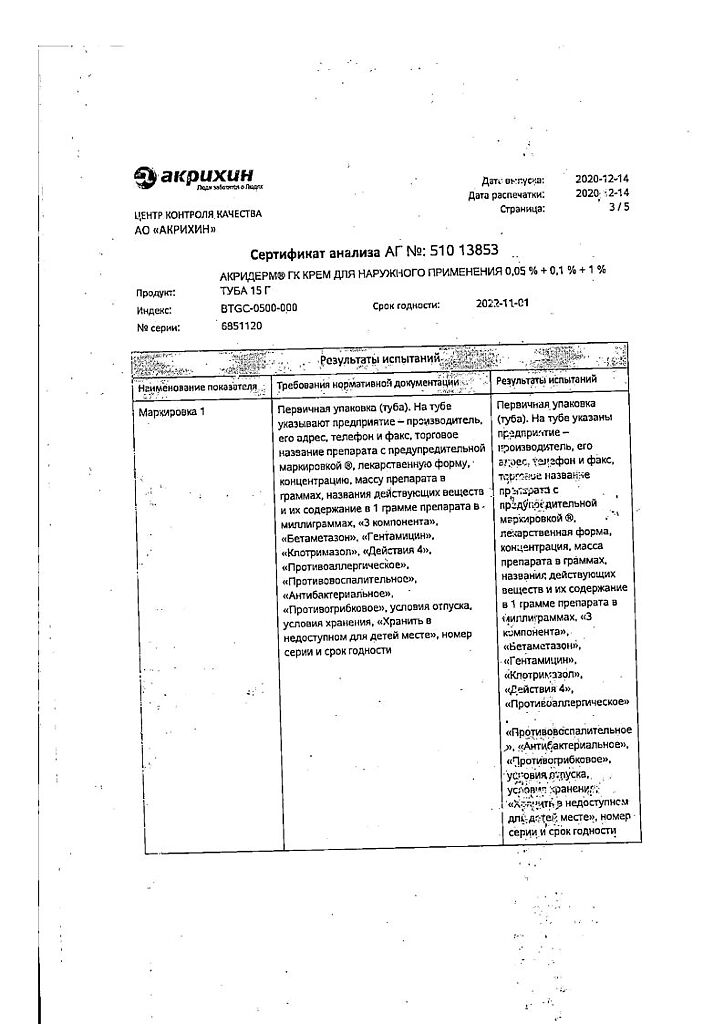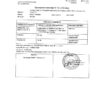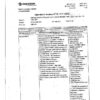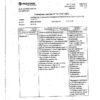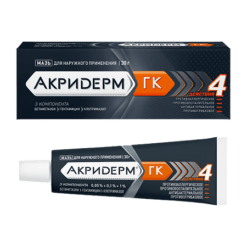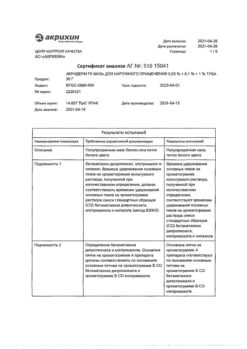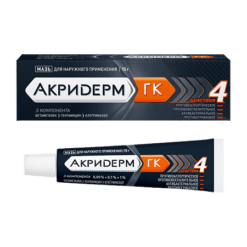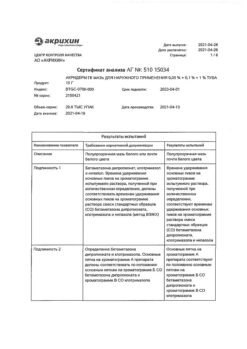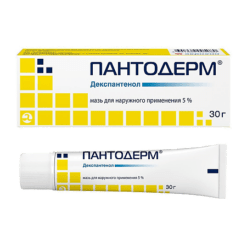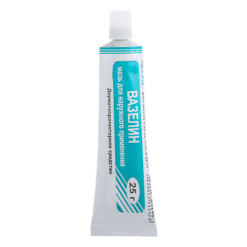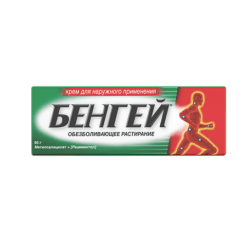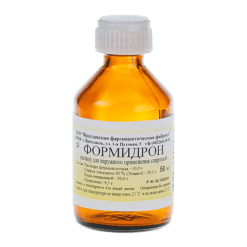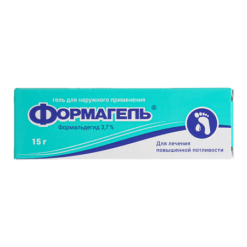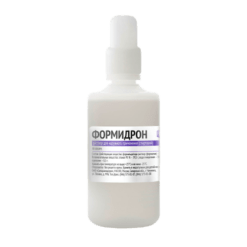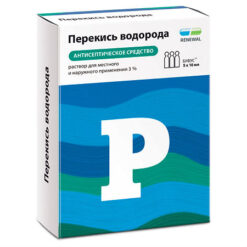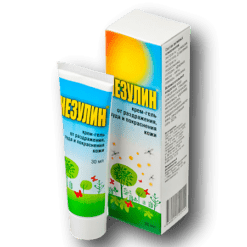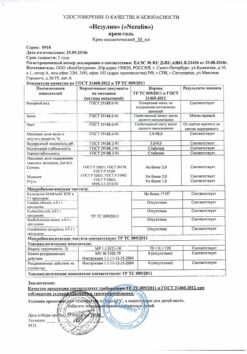No products in the cart.
Akriderm GC, 0.05%+0.1%+1% cream 15 g
€17.81 €14.84
Description
Acriderm GC is a combined drug with anti-inflammatory, anti-allergic, antibacterial and antifungal (fungicidal) effect.
Gentamicin is a broad-spectrum antibiotic of the group of aminoglycosides, has a bactericidal effect. Highly susceptible gram-negative microorganisms – Proteus spp. (in-positive and indo-positive), Escherichia coli, Klebsiella spp., Salmonella spp., Shigella spp., Campylobacter spp., Staphylococcus spp. (methicillin-resistant). Sensitive: Enterococcus faecalis, Serratia spp., Pseudomonas spp., Acinetobacter spp., Citrobacter spp. Resistant: Neisseria meningitidis, Treponema pallidum, anaerobic microbes: Streptococcus spp. (except Streptococcus pneumoniae), Enterococcus faecalis; Providencia rettgeri.
Betamethasone is a glucocorticosteroid that has local anti-inflammatory, anti-edema, anti-allergic effects.
Clotrimazole is an antifungal agent from the group of imidazole derivatives for topical use. It acts by disrupting the synthesis of ergosterol, which is a part of the cell membrane of fungi. It has a wide spectrum of action. It is active against pathogenic dermatophytes (Trichophyton rubrum, Trichophyton mentagro- phytes, Epidermophyton floccosum, Microsporum canis), yeasts and molds (Candida spp., Torulopsis glabrata, Rhodotorula spp., Pityrosporum orbiculare).
Indications
Indications
Simple and allergic dermatitis (especially complicated by secondary infection), diffuse neurodermatitis (including atopic dermatitis), limited neurodermatitis (including simple chronic lichen), eczema, dermatomycosis (dermatophytosis, candidiasis, lichen versicolor), especially when localized in the groin area and large folds of the skin.
Pharmacological effect
Pharmacological effect
Pharmacotherapeutic group: glucocorticosteroid for local use + antibiotic-aminoglycoside + antifungal agent
ATX code: D07XC01
Pharmacological properties
Pharmacodynamics
The combined drug has anti-inflammatory, antiallergic, antibacterial and antifungal (fungicidal) effects.
Gentamicin is a broad-spectrum antibiotic from the group of aminoglycosides that has a bactericidal effect. Highly sensitive gram-negative microorganisms – Proteus spp. (indole-positive and indole-negative), Escherichia coli, Klebsiella spp., Salmonella spp., Shigella spp., Campylobacter spp., Staphylococcus spp. (methicillin-resistant). Sensitive: Enterococcus faecalis, Serratia spp., Pseudomonas spp., Acinetobacter spp., Citrobacter spp. Resistant: Neisseria meningitidis, Treponema pallidum, anaerobic microbes: Streptococcus spp. (except Streptococcus pneumoniae), Enterococcus faecalis; Providencia rettgeri. Betamethasone is a glucocorticosteroid that has local anti-inflammatory, anti-edematous, and anti-allergic effects. Clotrimazole is an antifungal agent from the group of imidazole derivatives for topical use. It has an effect by disrupting the synthesis of ergosterol, which is an integral part of the cell membrane of fungi. Has a wide spectrum of action. Active against pathogenic dermatophytes (Trichophyton rubrum, Trichophyton mentagrophytes, Epidermophyton floccosum, Microsporum canis), yeast and mold fungi (Candida spp., Torulopsis glabrata, Rhodotorula spp., Pityrosporum orbiculare).
Pharmacokinetics
When the drug is applied cutaneously in therapeutic doses, transdermal absorption of the active substances into the blood is very insignificant. When applied to the skin, the intensity of absorption of betamethasone depends on the state of the epidermal barrier (inflammation and skin diseases increase absorption). The use of occlusive dressings increases the transdermal absorption of betamethasone and gentamicin, which may lead to an increased risk of systemic side effects.
Special instructions
Special instructions
Avoid contact with eyes.
If resistant bacterial or fungal microflora appears, the drug should be discontinued and appropriate therapy should be prescribed.
Due to the fact that in children the area of skin in relation to body weight is larger than in adults, and the epidermis is underdeveloped, when the drug is used externally, it is possible to absorb a proportionally larger amount of active substances and, therefore, there is a greater risk of developing systemic side effects. The drug should be used in children for the shortest possible time and with all precautions.
Active ingredient
Active ingredient
Betamethasone, Gentamicin, Clotrimazole
Composition
Composition
100 g of cream contains:
active ingredients: betamethasone dipropionate (betamethasone dipropionate micronized) in terms of 100% substance – 0.064 g, which is equivalent to 0.05 g of betamethasone, gentamicin sulfate in terms of gentamicin – 0.100 g, clotrimazole in terms of 100% substance – 1.000 g;
excipients: petrolatum, propylene glycol, liquid paraffin, cetostearyl alcohol [cetyl alcohol 60%, stearyl alcohol 40%], macrogol cetostearate (macrogol-20 cetostearyl ether), disodium edetate, sodium dihydrogen phosphate dihydrate, purified water.
Pregnancy
Pregnancy
During pregnancy (especially in the first trimester), topical use of the cream in pregnant women is allowed only in cases where the expected benefit to the mother outweighs the potential risk to the fetus. In such cases, the use of the drug should be short-term and limited to small areas of the skin.
It is not known whether the components of the drug are excreted in breast milk. Therefore, when prescribing Akriderm GK cream during lactation, it is recommended to stop breastfeeding.
Contraindications
Contraindications
Hypersensitivity to any of the components of the drug, skin tuberculosis, skin manifestations of syphilis, chicken pox, herpes simplex, skin
post-vaccination reactions, open wounds, children’s age (up to 2 years).
With caution
Pregnancy (especially 1st trimester). Children’s age from 2 to 18 years.
Side Effects
Side Effects
Itching, burning, irritation, dry skin, folliculitis, hypertrichosis, steroid acne, hypopigmentation, allergic reactions. When using occlusive dressings – maceration, infection, skin atrophy, stretch marks, prickly heat. With prolonged treatment or application to a large surface – the development of systemic side effects: weight gain, osteoporosis, increased blood pressure, edema, ulceration of the mucous membrane of the gastrointestinal tract, exacerbation of hidden foci of infection, hyperglycemia, agitation, insomnia, dysmenorrhea.
Interaction
Interaction
The interaction of Akriderm GK with other drugs has not been established.
Overdose
Overdose
Symptoms: phenomena of hypercortisolism.
Treatment: gradual withdrawal of the drug. Symptomatic therapy. If necessary, correct electrolyte disturbances.
Storage conditions
Storage conditions
At temperatures from 15 to 25 oC.
Keep out of the reach of children.
Shelf life
Shelf life
2 years.
Do not use after expiration date.
Manufacturer
Manufacturer
Akrikhin JSC, Russia
Additional information
| Shelf life | 2 years. |
|---|---|
| Conditions of storage | At a temperature of 15-25 °C. |
| Manufacturer | Akrihin HFC JSC, Russia |
| Medication form | exterior cream |
| Brand | Akrihin HFC JSC |
Other forms…
Related products
Buy Akriderm GC, 0.05%+0.1%+1% cream 15 g with delivery to USA, UK, Europe and over 120 other countries.




